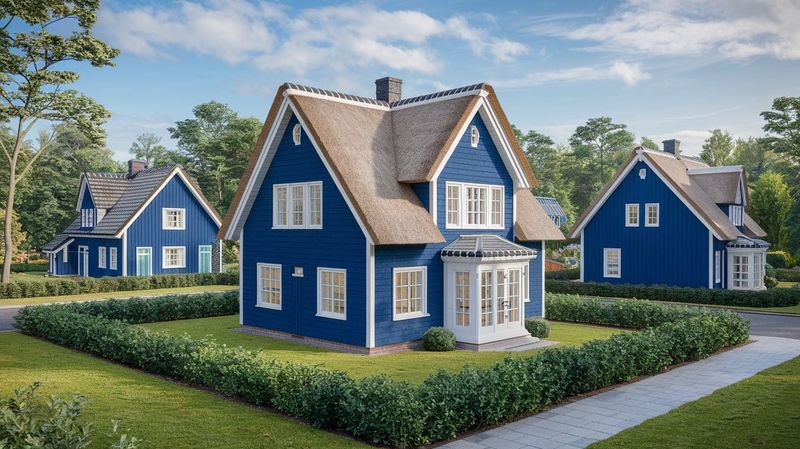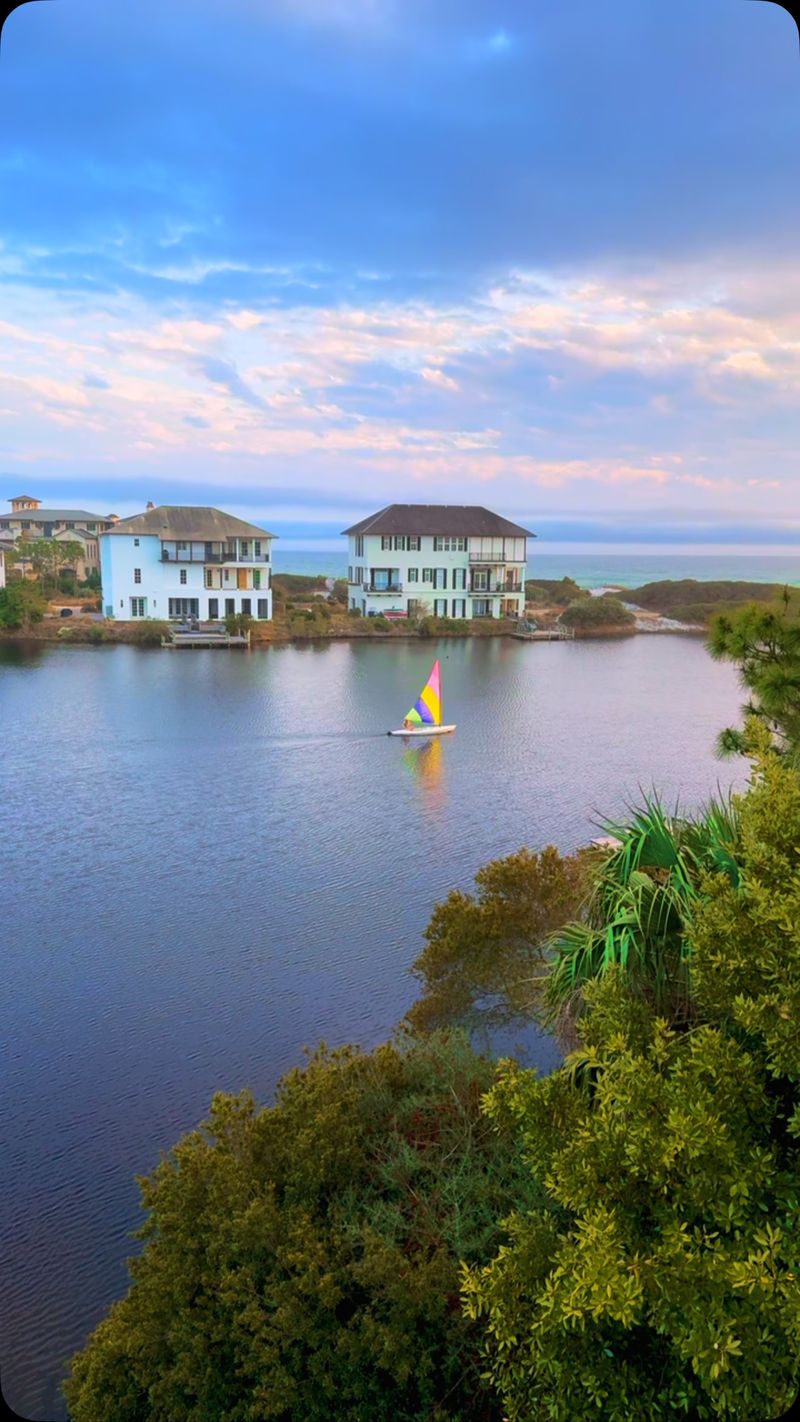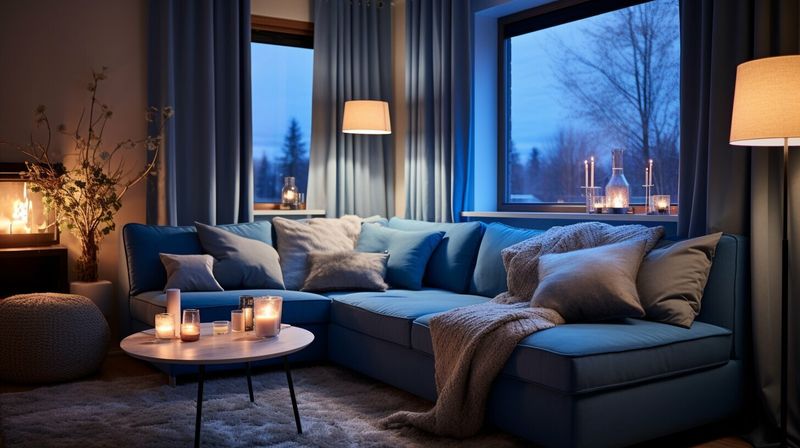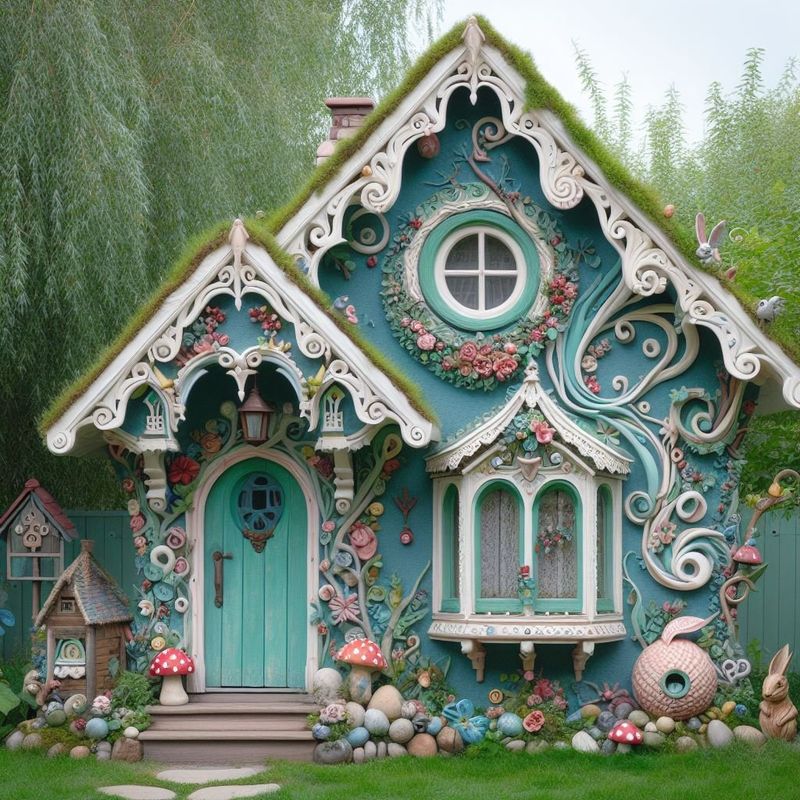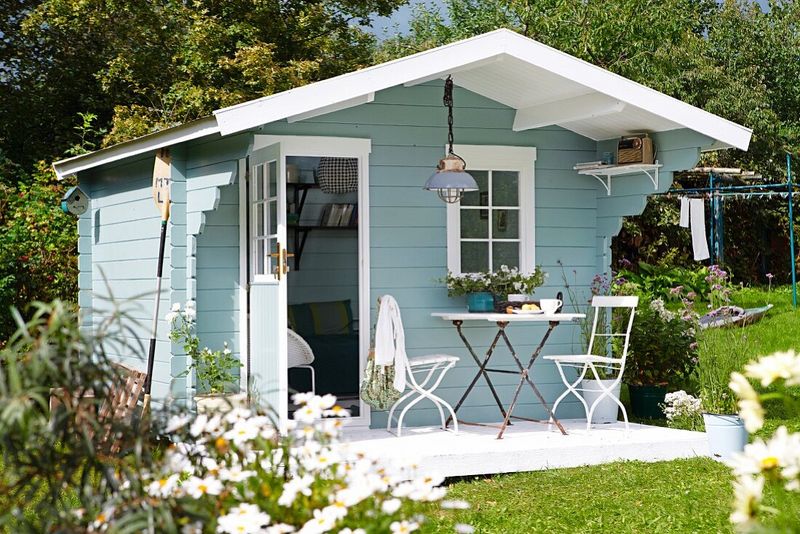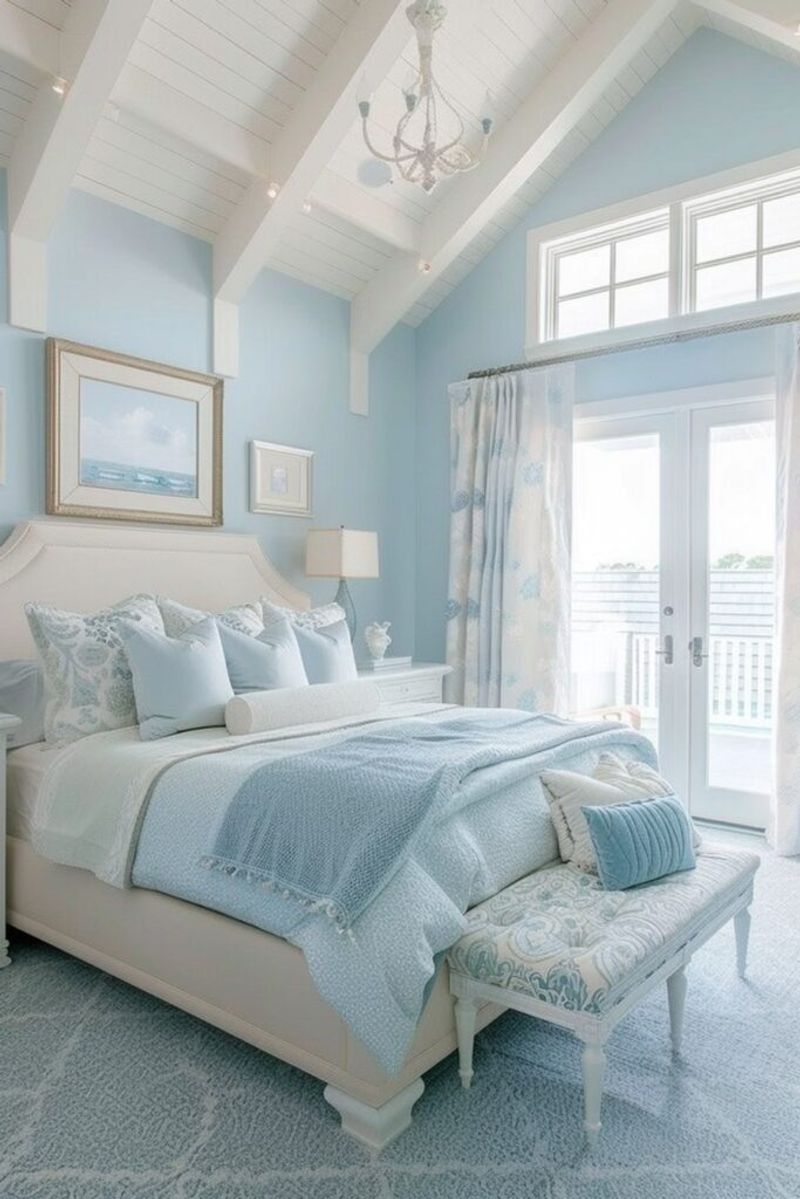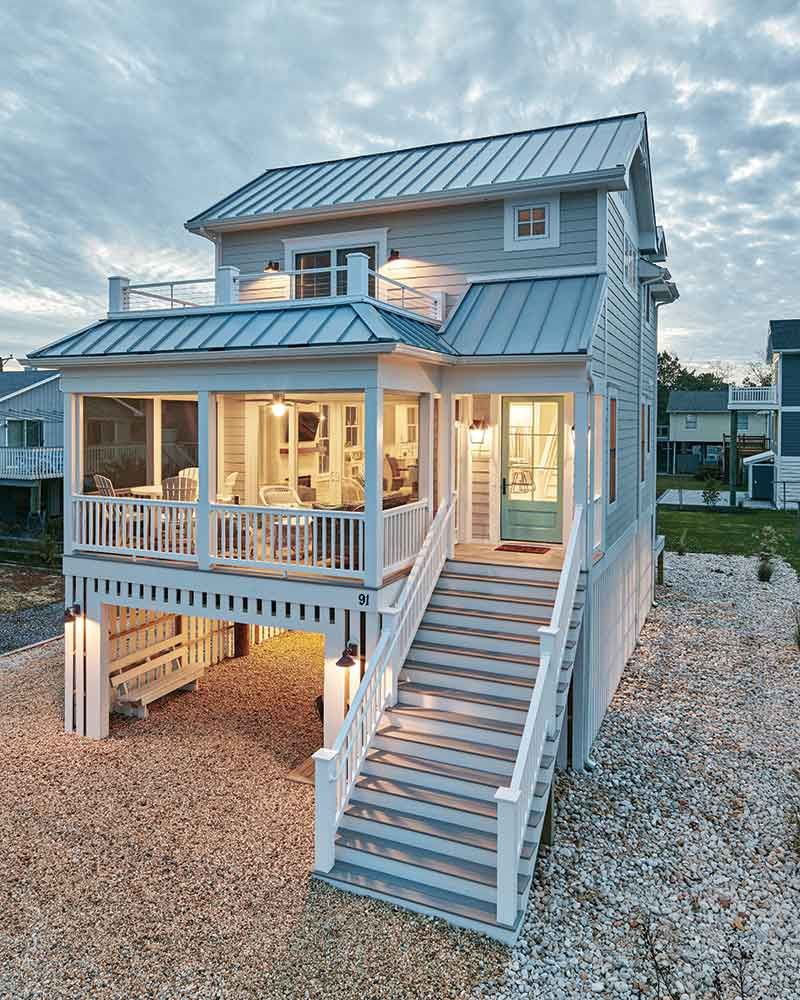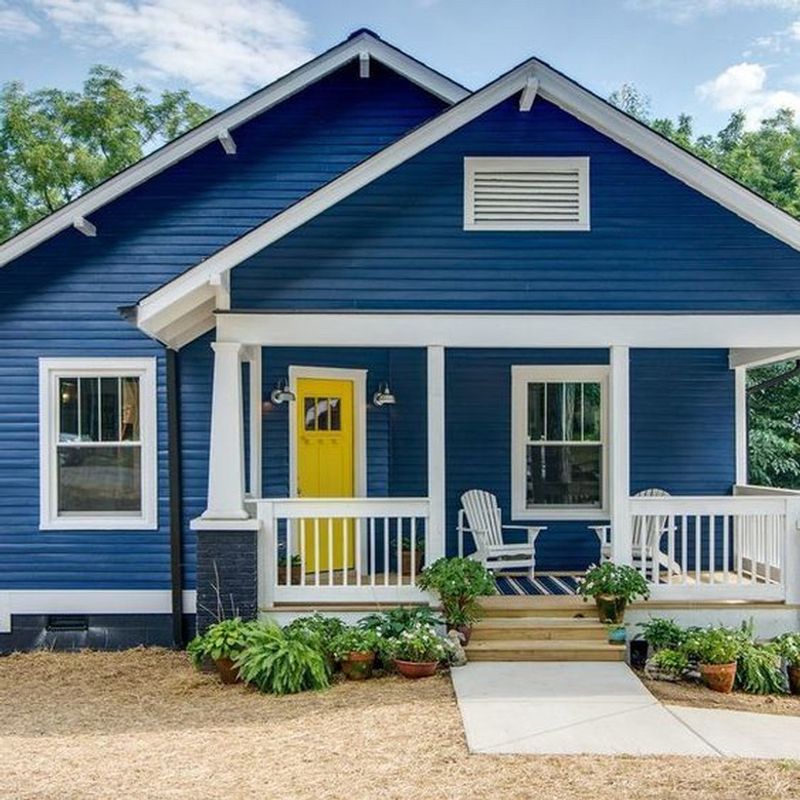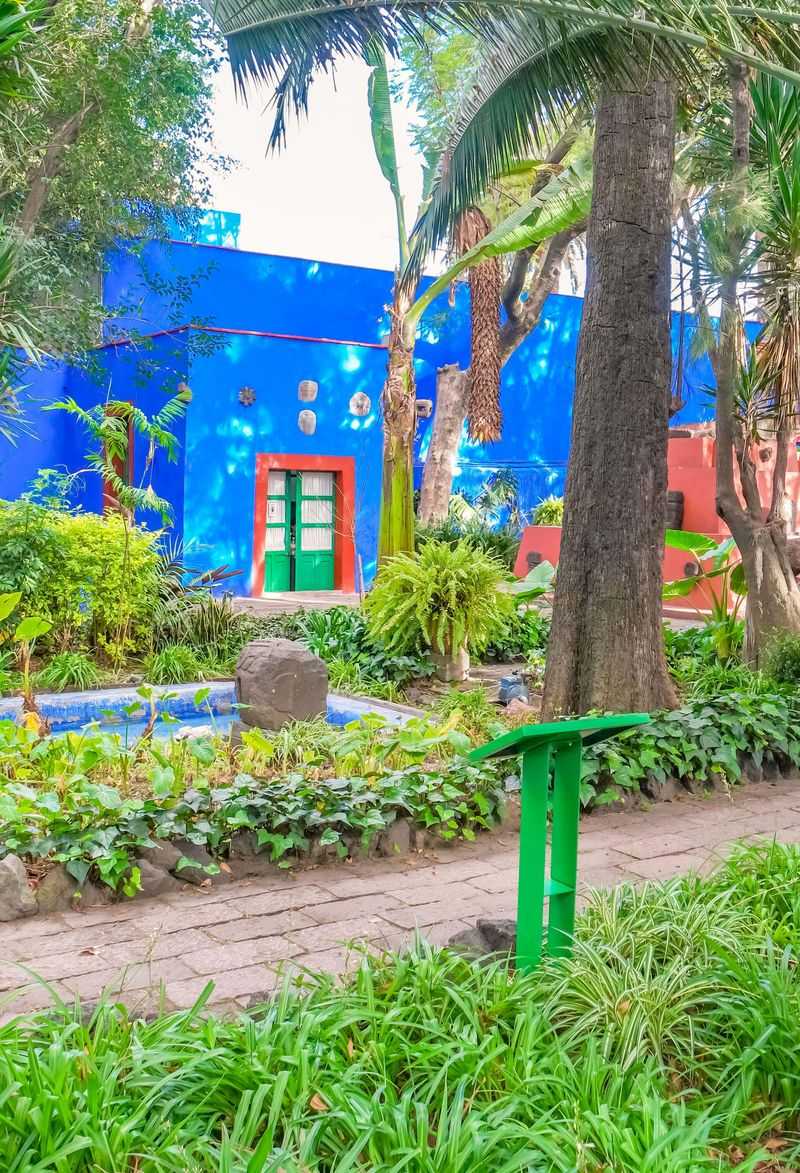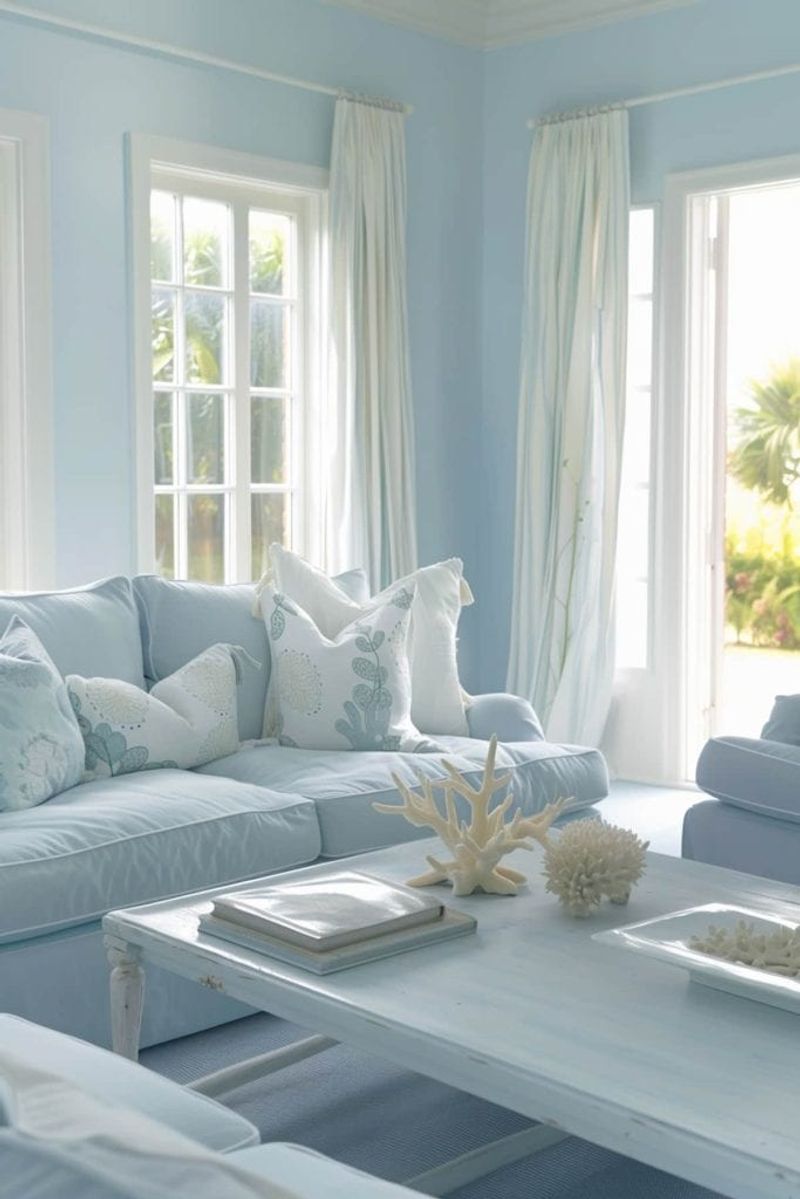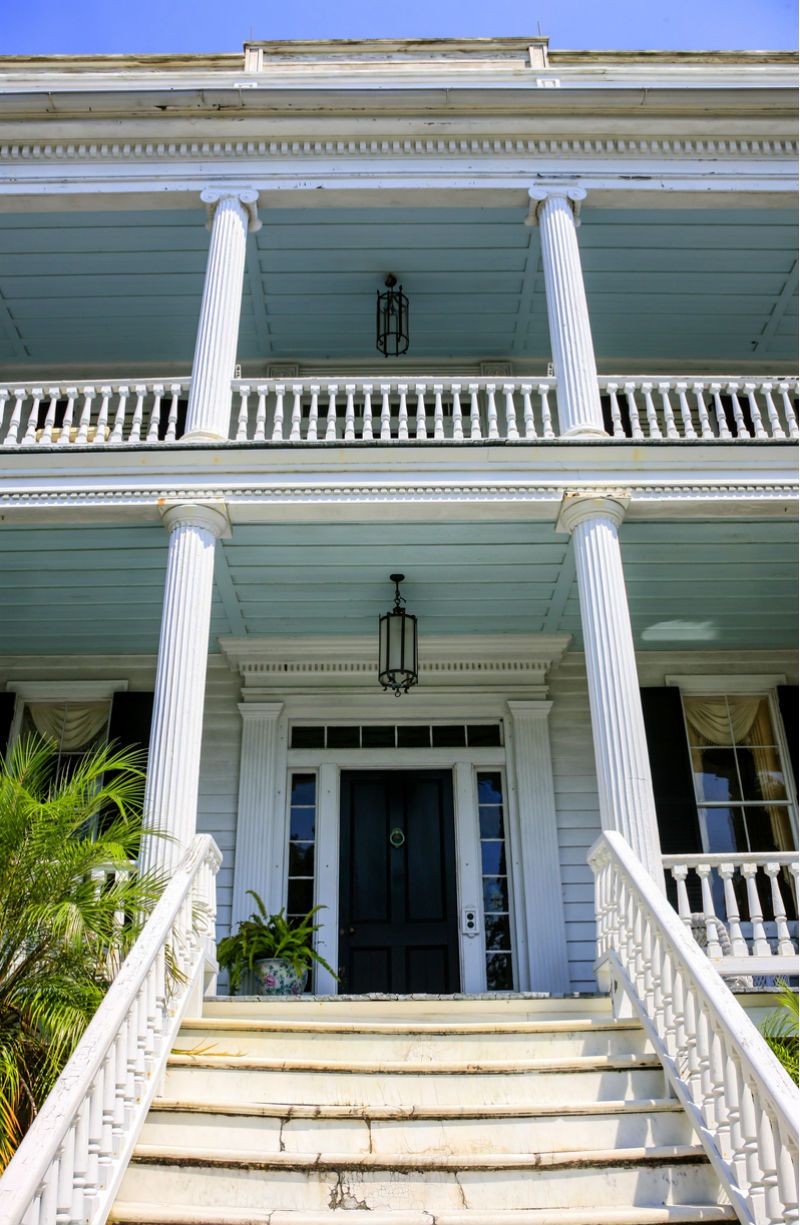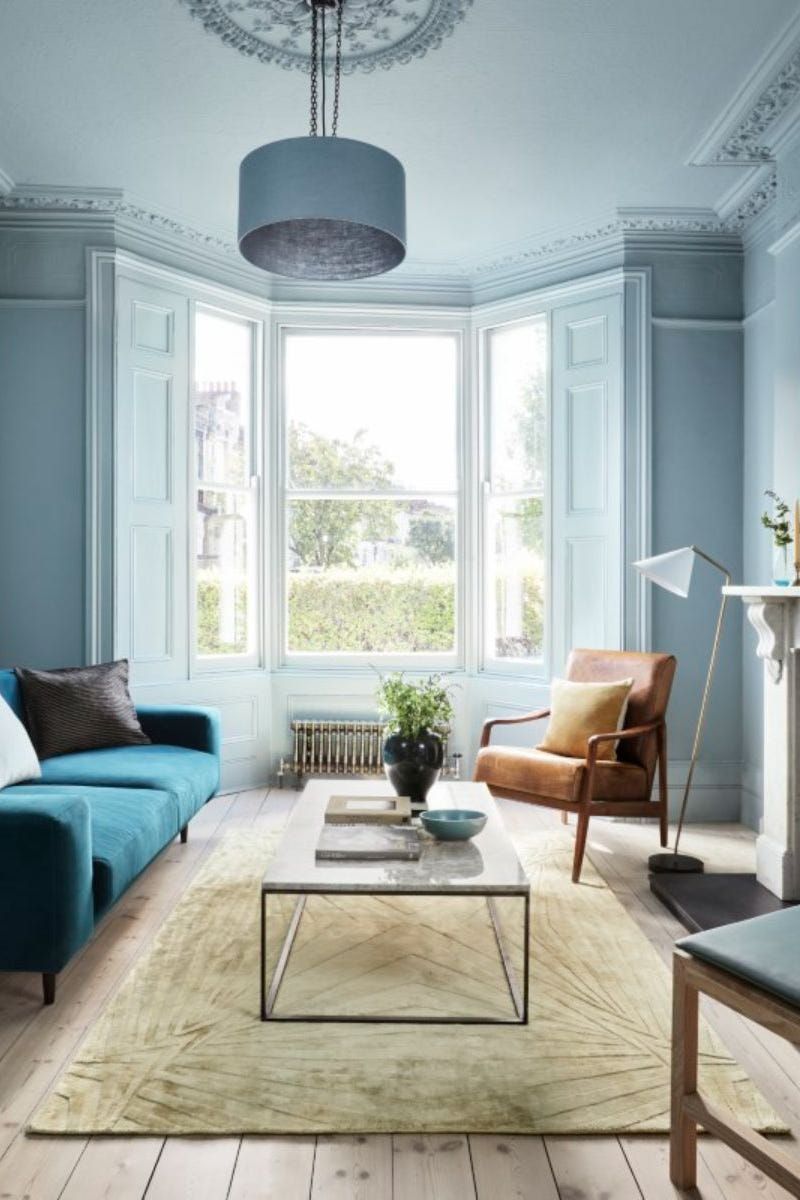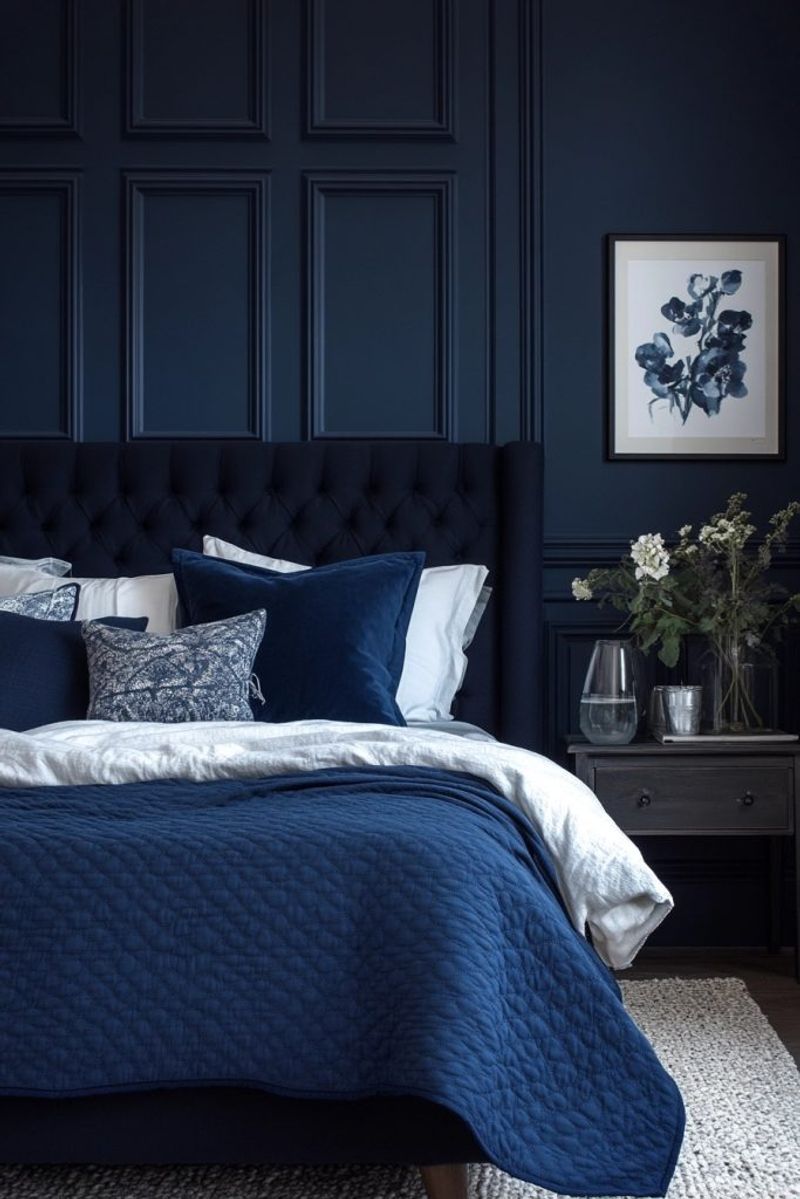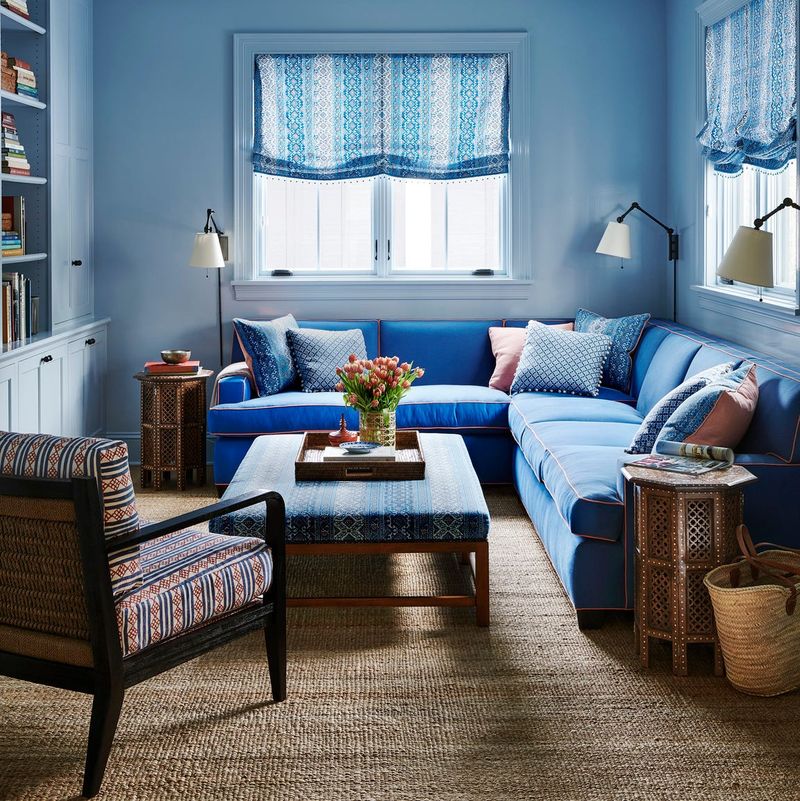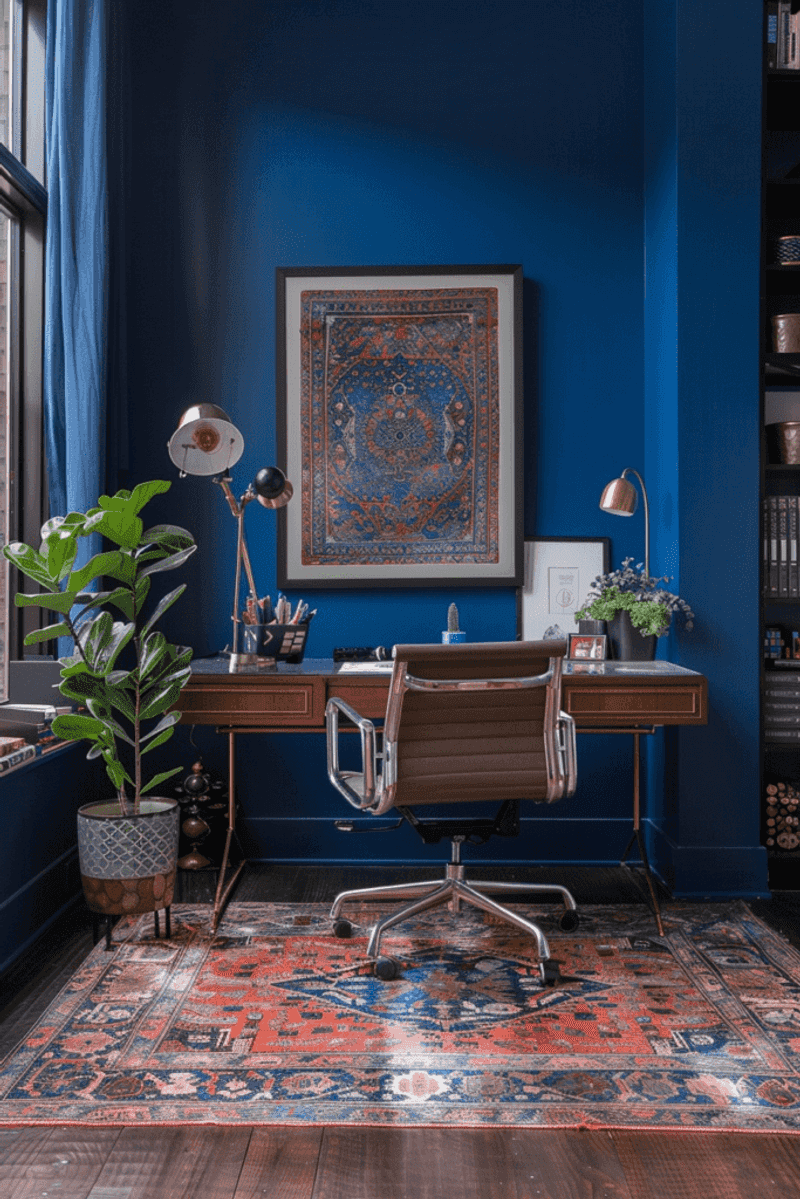There’s something magical about small blue houses that instantly soothes the soul and calms the mind.
These charming dwellings have captivated homeowners and passersby alike with their distinctive character and tranquil presence. Whether nestled by the seaside or tucked away in wooded neighborhoods, small blue homes create an atmosphere of serenity that’s hard to match.
Let’s explore why these azure abodes make us feel so wonderfully at peace.
1. Sky Connection
Have you ever noticed how a blue house seems to blend right into the sky? This visual harmony creates a seamless transition between your home and the heavens above, making the structure feel like a natural extension of the atmosphere.
The psychological effect is profound. Our brains associate this continuity with boundlessness and freedom, subconsciously removing the feeling of confinement that walls typically impose. Even on cloudy days, the blue exterior maintains this ethereal connection.
Many homeowners report feeling less boxed-in and more part of the wider world in their blue dwellings, as if the boundaries between inside and outside have gently dissolved.
2. Water Reminiscence
Gazing at a blue house often triggers the same calming brain response we experience when looking at oceans, lakes, or gentle streams. This innate reaction is deeply rooted in our evolutionary history, where water meant survival and prosperity.
The varying shades of blue – from pale aqua to deep navy – mirror the diverse hues of natural waters. When sunlight plays across these surfaces, it creates the same dancing reflections we love in waterside settings.
Subconsciously, we’re transported to peaceful shorelines or serene lakes, even when standing in suburban neighborhoods or city streets, bringing that vacation feeling home.
3. Color Psychology Benefits
Throughout history, blue has reigned supreme as the color most associated with tranquility and inner peace. The science behind this is fascinating – exposure to blue actually decreases blood pressure and slows respiration rates in most people.
When you’re surrounded by a blue home, this calming effect works continuously, creating a buffer zone between the hectic outside world and your personal sanctuary. Unlike stimulating colors like red or yellow, blue doesn’t demand attention; it offers a gentle backdrop for daily life.
This subtle psychological influence helps explain why people often lose track of time in blue spaces, experiencing what psychologists call a ‘flow state’ more readily.
4. Storybook Charm
Tucked between the pages of our favorite childhood tales, blue cottages have long symbolized magic and possibility. From Little Boy Blue to the home of the Smurfs, these azure dwellings populate the landscapes of imagination and wonder.
Walking up to a small blue house triggers those same feelings of enchantment we experienced when first hearing those stories. The color itself seems to whisper that something special awaits inside, something beyond the ordinary.
Many blue homeowners confess they chose the color precisely because it made them feel like they were living in their own fairytale – a daily reminder that life can indeed be magical.
5. Scandinavian Influence
Across the fjords and islands of Scandinavia, blue homes dot the landscape like sapphires against snow and greenery. This tradition stems from practical origins – copper sulfate, which produces blue paint, naturally repels insects and preserves wood in harsh northern climates.
Beyond functionality, Nordic cultures embrace the concept of ‘hygge’ – that untranslatable sense of coziness and contentment. Blue exteriors paired with warm, wood-filled interiors epitomize this philosophy, creating contrast that heightens the feeling of snug security inside.
Modern small blue houses channel this centuries-old wisdom, marrying exterior tranquility with interior warmth in perfect Nordic balance.
6. Space-Enhancing Properties
Optical illusions aren’t just for art galleries – they work wonders in architecture too! Blue houses appear to recede visually, creating the perception of more space around them than actually exists. This visual trick makes even the smallest cottage feel less cramped and more open.
Inside, blue walls work similar magic, pushing boundaries outward and making rooms feel larger and airier. Combined with natural light, these blue surfaces reflect softly rather than harshly, eliminating the closed-in feeling that plagues many small homes.
Clever homeowners use this spatial advantage by choosing lighter blues for tiny rooms and deeper shades for spaces where they want to create intimate conversation areas.
7. Seaside Nostalgia
Memories of childhood vacations come flooding back when we encounter small blue houses. That’s because coastal communities worldwide have traditionally painted their homes in ocean-inspired hues, creating iconic seascapes from Greece to Cape Cod.
The association is powerful – one glimpse of a blue cottage and suddenly you can almost taste the salt air, hear seagulls calling, and feel sand between your toes. This sensory time-travel explains why blue homes often evoke unexpected happiness even for first-time visitors.
For many homeowners, painting their house blue serves as a daily reminder of carefree days by the shore, bringing vacation vibes into everyday life.
8. Contrast With Natural Elements
Mother Nature rarely uses blue in her landscape palette, making blue houses stand out against her backdrop in the most harmonious way possible. Against green foliage, brown earth, or white snow, blue creates a focal point without shouting for attention.
This natural contrast makes gardens pop with extra vibrancy – red roses, yellow daffodils, and purple lavender all seem to bloom more intensely against a blue backdrop. The same goes for natural wood elements like porches and garden furniture, which gain warmth and character from the cool contrast.
Landscapers often recommend blue exteriors specifically because they make outdoor spaces feel more cohesive and intentionally designed.
9. Community Distinctiveness
Standing out while fitting in represents the perfect balance many homeowners seek. Blue houses achieve this delicate equilibrium by being distinctive without being flashy or inappropriate – they’re memorable without screaming for attention.
In neighborhoods of beige and gray, a thoughtfully chosen blue exterior becomes a beloved landmark that helps visitors navigate (‘turn left at the lovely blue cottage’). This gentle distinctiveness often makes blue houses community favorites, frequently featured on neighborhood walking tours and local postcards.
Many blue homeowners report stronger community connections, with their homes becoming natural gathering points that neighbors reference with affection rather than criticism.
10. Reduced Visual Noise
In today’s visually overwhelming world, blue houses offer a respite for tired eyes and minds. Unlike trendy color schemes that demand attention, blue recedes visually, creating what designers call ‘negative space’ – areas where the eye can rest comfortably.
Walking into a blue environment literally lowers visual stress. Studies show that people process information more thoroughly and feel less mentally cluttered in blue surroundings, explaining why we feel instantly more collected and calm in these spaces.
Many blue homeowners report that friends comment on feeling ‘like they can finally breathe’ when visiting – a testament to blue’s unique ability to quiet the visual noise of modern life.
11. Historical Significance
Throughout history, blue pigments were among the most difficult and expensive to produce, making blue houses a subtle symbol of refinement rather than ostentatious wealth. From indigo-dyed shutters to lapis-tinted exteriors, blue has signaled quiet sophistication for centuries.
In American colonial architecture, blue porch ceilings originated from the Gullah Geechee tradition of ‘haint blue’ – believed to ward off restless spirits while welcoming ancestors. This protective symbolism adds a layer of cultural meaning that resonates even with those unaware of its origins.
Living in a blue house connects you to this rich historical tapestry, lending even new constructions a sense of timelessness and continuity.
12. Temperature Perception
Stepping into a blue house triggers an immediate cooling sensation, even when the actual temperature hasn’t changed. This psychological cooling effect makes blue homes feel particularly refreshing during warm months without additional energy costs.
Conversely, when paired with warm elements like wooden beams, crackling fireplaces, or amber lighting, blue creates the perfect temperature contrast. This juxtaposition enhances the perceived warmth of cozy elements while maintaining an overall sense of coolness and calm.
Smart homeowners play with this perception, using deeper blues in sun-drenched rooms and lighter shades in spaces that need warming, effectively creating microclimates throughout their homes.
13. Sleep-Promoting Environment
Wonder why you sleep so soundly in a blue bedroom? Sleep researchers have found that exposure to blue environments significantly increases production of melatonin, the hormone responsible for quality sleep. This effect extends beyond bedrooms to the entire house.
Living in a blue home means you’re constantly surrounded by colors that signal your brain to maintain healthy sleep-wake cycles. Many blue homeowners report improved sleep quality and easier morning waking compared to their experiences in differently colored homes.
For those struggling with insomnia or disrupted sleep patterns, a blue living environment can be part of a holistic approach to better rest without medication.
14. Simplified Decision Making
Walking through any home decor store reveals an overwhelming truth – almost everything matches blue! This decorating superpower means blue homeowners face fewer agonizing design decisions and enjoy more successful outcomes with their interior choices.
From furniture to artwork, textiles to tableware, blue serves as a versatile backdrop that accommodates virtually any style or accent color. This flexibility extends to seasonal decorating too, with blue complementing everything from spring florals to winter evergreens with equal grace.
Many interior designers start with blue specifically because it provides the widest palette of possibilities while minimizing the risk of clashing elements.
15. Creative Inspiration
Artists, writers, and musicians have long gravitated toward blue environments when seeking their muse. The science behind this phenomenon suggests that blue surroundings activate the right brain – the hemisphere associated with creativity, intuition, and holistic thinking.
Many famous works of literature, music, and visual art have been created within blue walls. Picasso’s Blue Period, while melancholy in theme, produced some of his most introspective and innovative work, demonstrating blue’s power to deepen creative thought.
For those working from home, blue spaces can enhance problem-solving abilities and original thinking, making a blue house the perfect incubator for new ideas.


